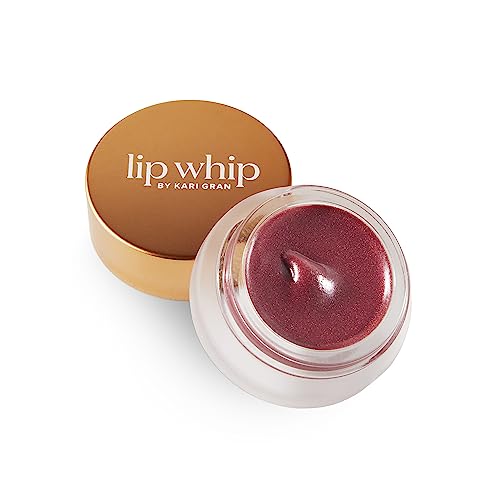

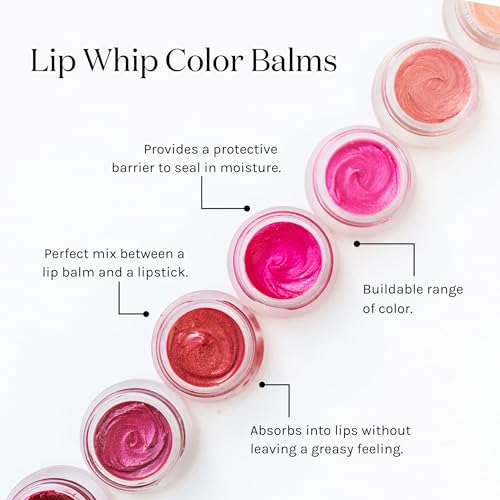
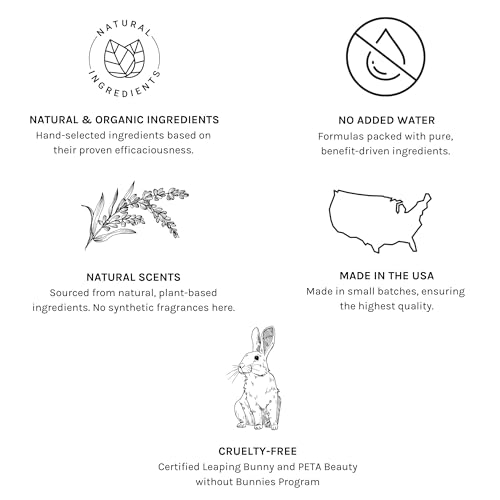

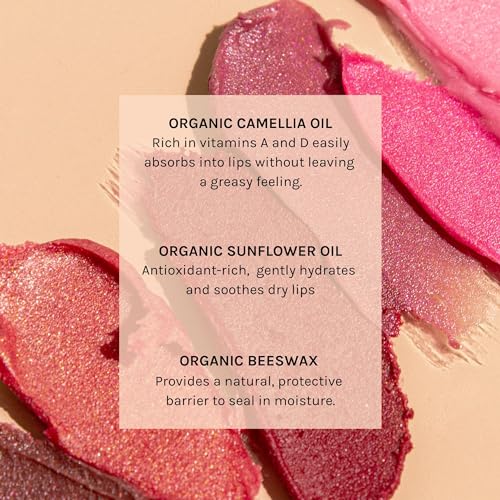
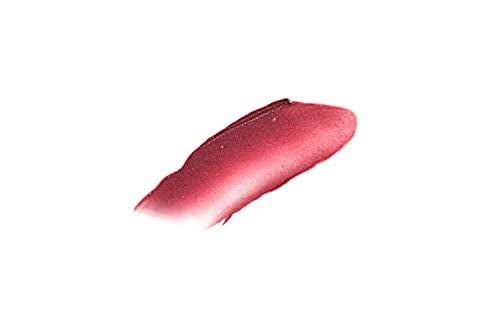
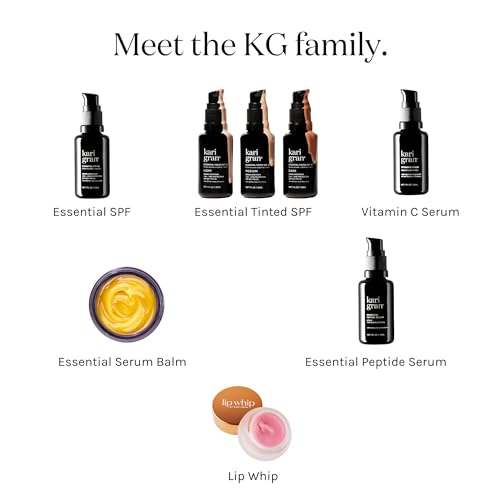
Kari Gran Lip Whip - Moisturizing Lip Balm, Rich Berry Color, Organic Ingredients - 0.15oz


Mentha Piperita (Peppermint) Oil
High RiskMentha piperita (peppermint) oil is a volatile oil extracted from the leaves of the peppermint plant, known for its strong aroma and flavor. It is commonly used in cosmetics and personal care products for its cooling properties and fragrance enhancement.
Sustai Insights
Peppermint oil offers functional benefits such as antimicrobial properties and a soothing sensation on the skin. However, it is associated with a high potential for allergies and skin irritation. Regulatory bodies impose certain restrictions on its use due to these concerns. The overall risk level is assessed as high, warranting caution in usage, especially for sensitive populations. Alternatives like spearmint oil may provide similar benefits with potentially lower irritation risks.
Silica, Amorphous
Medium RiskSilica, amorphous, is a common constituent of sand and is often used in various products for its properties as an anti-caking agent, thickener, or stabilizer. It plays a crucial role in improving the texture and flow of formulations.
Sustai Insights
Amorphous silica offers functional benefits such as enhancing product texture and acting as an anti-caking agent. It poses low health risks, with minimal concerns regarding carcinogenicity, allergenic potential, and reproductive toxicity. Environmental risks are low; however, its lifecycle may involve pollution and bioaccumulation. Regulatory bodies have imposed some restrictions on its use, leading to a medium risk assessment overall. Safe usage practices should be followed, and alternatives like natural clays may provide similar benefits with reduced environmental impact.
Ricinus Communis (Castor) Seed Oil
Medium RiskCastor oil is extracted from the seeds of Ricinus communis and is commonly used in cosmetic and personal care products for its moisturizing and emollient properties. It is known for its ability to enhance skin absorption and provide a protective barrier.
Sustai Insights
Castor oil offers functional benefits as a moisturizer and emollient, enhancing skin absorption and providing a barrier against moisture loss. It is sustainably sourced and biodegradable. However, potential health risks include low levels of irritation and moderate concerns regarding developmental and reproductive toxicity. Environmental risks are low, with no significant pollutant or bioaccumulation concerns reported. Regulatory status shows no current restrictions. Overall, the risk level is assessed as medium, with recommendations for safe usage practices, and potential alternatives include other plant-based oils.
Titanium Dioxide
Medium RiskTitanium dioxide is an inorganic compound used primarily as a pigment due to its brightness and high refractive index. It is commonly found in products such as paints, coatings, plastics, and cosmetics, providing color and opacity.
Sustai Insights
Titanium dioxide serves effectively as a UV filter and colorant, enhancing product stability and performance. However, it has been classified as a moderate concern for potential carcinogenicity and carries low risks for allergies and reproductive toxicity. Environmental risks include its pollutant potential, though it is not known to bioaccumulate. Regulatory bodies have issued specific restrictions regarding its use, leading to an overall medium risk assessment. Safe usage practices should be observed, with consideration for alternatives such as zinc oxide for a more sustainable option.
Camellia Oleifera Seed Oil
Low RiskCamellia oleifera seed oil is an extract from the seeds of the Camellia oleifera plant, commonly used in cosmetic formulations for its moisturizing properties and potential skin benefits.
Sustai Insights
Camellia oleifera seed oil offers functional benefits as a moisturizer and emollient, being biodegradable and typically sustainably sourced. Health risks are low, with minimal concerns regarding carcinogenicity, allergenic potential, and reproductive toxicity. Environmental risks are also low, as it does not contribute significantly to pollution or bioaccumulation. Regulatory bodies do not impose restrictions on its use. Overall, the ingredient poses low risk when used appropriately, making it a favorable option in cosmetic products.
Mica
Low RiskMica is a type of highly brittle silicate mineral commonly used in cosmetics and personal care products for its reflective properties and texture. It serves primarily as a colorant and opacifying agent, enhancing the aesthetic appeal of formulations.
Sustai Insights
Mica provides functional benefits such as adding shimmer and improving the texture of cosmetics. It is generally considered low risk concerning health concerns like carcinogenicity and allergenic potential. However, there are risks associated with its persistence and potential for bioaccumulation in the environment. Regulatory bodies have noted some restrictions on mica sourcing due to ethical concerns surrounding mining practices. Overall, while mica has low health risks, its environmental impact necessitates careful sourcing and consideration of alternatives like synthetic colorants or other natural minerals.
Caledula Officinalis Extract
Low RiskCalendula officinalis extract is derived from the flowers of the calendula plant. It is commonly used in cosmetic and personal care products for its soothing and anti-inflammatory properties.
Sustai Insights
Calendula extract offers functional benefits such as skin soothing and anti-inflammatory effects, making it useful in topical formulations. It is generally considered low risk for health concerns, including carcinogenicity, allergies, and reproductive toxicity. Environmental impact is minimal, with no significant pollutant potential noted. It is compliant with regulatory standards and has no known restrictions. Safe usage practices include conducting patch tests to avoid allergic reactions, and alternatives may include other botanical extracts like chamomile. Overall, the ingredient is assessed to have a low risk.
Olea Europaea (Olive) Oil
Low RiskOlea europaea (olive) oil is derived from the ripe fruit of the olive tree. It is commonly used in cosmetic formulations primarily as a moisturizer and emollient due to its nourishing properties for the skin. It also serves as a carrier oil for other ingredients in formulations.
Sustai Insights
Olea europaea (olive) oil offers numerous functional benefits, including effective moisturization and enhanced skin absorption properties, making it suitable for various cosmetic applications. It is a biodegradable ingredient, contributing to sustainability when sourced responsibly. Health risks are low, with minimal concerns regarding carcinogenicity, allergenic potential, and developmental toxicity. Environmental risks are also low, with no significant bioaccumulation or pollution potential noted. Regulatory bodies do not impose restrictions on its use. Overall, olive oil presents a low risk profile, making it a favorable choice in cosmetic products.
Beeswax
Low RiskBeeswax is the purified wax obtained from the honeycomb of honeybees. It is typically used as a thickening agent, emulsifier, or to provide structure in various cosmetic and personal care products.
Sustai Insights
Beeswax offers functional benefits as a natural emulsifier and thickening agent, contributing to product stability and texture. It is biodegradable and sustainably sourced, aligning with eco-friendly practices. Health risks are low, with minimal concerns regarding carcinogenicity, allergies, or irritation. Environmental risks are also low, with no significant pollutant or bioaccumulation issues. Regulatory bodies impose few restrictions, confirming its safety in use. Safe usage practices should be followed, and alternatives like plant-based waxes may be considered for those seeking vegan options. Overall, the risk level associated with beeswax is low.
Manganese Violet
Low RiskManganese violet is an inorganic salt formed from ammonium manganese phosphate, primarily used as a pigment in cosmetics and personal care products. It imparts a vivid violet color and is valued for its stability and opacity in formulations.
Sustai Insights
Manganese violet serves effectively as a colorant, contributing to aesthetic appeal in various products. It is considered to have low health risks, including negligible concerns regarding carcinogenicity, allergies, and reproductive toxicity. Environmentally, it poses low risks, being neither bioaccumulative nor a significant pollutant. Regulatory bodies, including the FDA, have imposed certain restrictions on its use but deem it generally safe when used appropriately. Overall, it presents a low risk profile, making it a suitable choice for formulation in personal care applications.
Ci 75470
Low RiskCarmine is a red pigment/dye derived from insect sources, specifically the cochineal insect. It is primarily used in food, cosmetics, and textiles to provide a vibrant red color. Carmine is listed under the color additive regulations and is recognized for its ability to impart rich hues to products.
Sustai Insights
Carmine serves as an effective colorant with functional benefits in various applications, being biodegradable and derived from natural sources, which can contribute to sustainability. Health risks are minimal, with low concerns regarding carcinogenicity, allergies, and reproductive toxicity. However, it is subject to restrictions due to allergenic potential in sensitive individuals. Regulatory bodies have acknowledged its safe use with proper labeling. Overall, the risk level associated with carmine is low, making it a suitable choice in products when used appropriately, though alternatives like synthetic dyes exist for those seeking vegan options.
Tocopherol
Low RiskTocopherols are a class of naturally occurring compounds, primarily known for their role as antioxidants. They are commonly used in cosmetic and skincare products to help stabilize formulations and protect ingredients from oxidative damage.
Sustai Insights
Tocopherols provide functional benefits such as antioxidant protection and skin conditioning. They are generally recognized as safe, with low concerns regarding carcinogenicity, allergies, and reproductive toxicity. However, enhanced skin absorption and potential endocrine disruption are noted. Regulatory bodies have not imposed significant restrictions on tocopherols, categorizing the overall risk as low. Safe usage practices should be observed, and while alternatives exist, tocopherols remain a viable option in formulations.
Helianthus Annuus (Sunflower) Seed Oil
Low RiskHelianthus annuus (sunflower) seed oil is derived from the seeds of the sunflower plant. It serves primarily as an emollient and moisturizer in cosmetic formulations, helping to maintain skin hydration and improve texture.
Sustai Insights
Sunflower seed oil is effective as an emollient, providing moisture and improving skin texture while being biodegradable and sustainably sourced. It poses low health risks, including negligible concerns for carcinogenicity, allergies, or reproductive toxicity. Environmentally, it does not significantly contribute to pollution or bioaccumulation. Regulatory bodies currently do not list any advisories for this ingredient. Overall, it is assessed as low risk, with safe usage practices recommended. Alternatives include oils like jojoba or almond oil for those seeking different properties.
Silica, Amorphous
Medium RiskSilica, amorphous, is a common constituent of sand and is often used in various products for its properties as an anti-caking agent, thickener, or stabilizer. It plays a crucial role in improving the texture and flow of formulations.
Sustai Insights
Amorphous silica offers functional benefits such as enhancing product texture and acting as an anti-caking agent. It poses low health risks, with minimal concerns regarding carcinogenicity, allergenic potential, and reproductive toxicity. Environmental risks are low; however, its lifecycle may involve pollution and bioaccumulation. Regulatory bodies have imposed some restrictions on its use, leading to a medium risk assessment overall. Safe usage practices should be followed, and alternatives like natural clays may provide similar benefits with reduced environmental impact.
Camellia Oleifera Seed Oil
Low RiskCamellia oleifera seed oil is an extract from the seeds of the Camellia oleifera plant, commonly used in cosmetic formulations for its moisturizing properties and potential skin benefits.
Sustai Insights
Camellia oleifera seed oil offers functional benefits as a moisturizer and emollient, being biodegradable and typically sustainably sourced. Health risks are low, with minimal concerns regarding carcinogenicity, allergenic potential, and reproductive toxicity. Environmental risks are also low, as it does not contribute significantly to pollution or bioaccumulation. Regulatory bodies do not impose restrictions on its use. Overall, the ingredient poses low risk when used appropriately, making it a favorable option in cosmetic products.
Mica
Low RiskMica is a type of highly brittle silicate mineral commonly used in cosmetics and personal care products for its reflective properties and texture. It serves primarily as a colorant and opacifying agent, enhancing the aesthetic appeal of formulations.
Sustai Insights
Mica provides functional benefits such as adding shimmer and improving the texture of cosmetics. It is generally considered low risk concerning health concerns like carcinogenicity and allergenic potential. However, there are risks associated with its persistence and potential for bioaccumulation in the environment. Regulatory bodies have noted some restrictions on mica sourcing due to ethical concerns surrounding mining practices. Overall, while mica has low health risks, its environmental impact necessitates careful sourcing and consideration of alternatives like synthetic colorants or other natural minerals.
Caledula Officinalis Extract
Low RiskCalendula officinalis extract is derived from the flowers of the calendula plant. It is commonly used in cosmetic and personal care products for its soothing and anti-inflammatory properties.
Sustai Insights
Calendula extract offers functional benefits such as skin soothing and anti-inflammatory effects, making it useful in topical formulations. It is generally considered low risk for health concerns, including carcinogenicity, allergies, and reproductive toxicity. Environmental impact is minimal, with no significant pollutant potential noted. It is compliant with regulatory standards and has no known restrictions. Safe usage practices include conducting patch tests to avoid allergic reactions, and alternatives may include other botanical extracts like chamomile. Overall, the ingredient is assessed to have a low risk.
Olea Europaea (Olive) Oil
Low RiskOlea europaea (olive) oil is derived from the ripe fruit of the olive tree. It is commonly used in cosmetic formulations primarily as a moisturizer and emollient due to its nourishing properties for the skin. It also serves as a carrier oil for other ingredients in formulations.
Sustai Insights
Olea europaea (olive) oil offers numerous functional benefits, including effective moisturization and enhanced skin absorption properties, making it suitable for various cosmetic applications. It is a biodegradable ingredient, contributing to sustainability when sourced responsibly. Health risks are low, with minimal concerns regarding carcinogenicity, allergenic potential, and developmental toxicity. Environmental risks are also low, with no significant bioaccumulation or pollution potential noted. Regulatory bodies do not impose restrictions on its use. Overall, olive oil presents a low risk profile, making it a favorable choice in cosmetic products.
Beeswax
Low RiskBeeswax is the purified wax obtained from the honeycomb of honeybees. It is typically used as a thickening agent, emulsifier, or to provide structure in various cosmetic and personal care products.
Sustai Insights
Beeswax offers functional benefits as a natural emulsifier and thickening agent, contributing to product stability and texture. It is biodegradable and sustainably sourced, aligning with eco-friendly practices. Health risks are low, with minimal concerns regarding carcinogenicity, allergies, or irritation. Environmental risks are also low, with no significant pollutant or bioaccumulation issues. Regulatory bodies impose few restrictions, confirming its safety in use. Safe usage practices should be followed, and alternatives like plant-based waxes may be considered for those seeking vegan options. Overall, the risk level associated with beeswax is low.
Manganese Violet
Low RiskManganese violet is an inorganic salt formed from ammonium manganese phosphate, primarily used as a pigment in cosmetics and personal care products. It imparts a vivid violet color and is valued for its stability and opacity in formulations.
Sustai Insights
Manganese violet serves effectively as a colorant, contributing to aesthetic appeal in various products. It is considered to have low health risks, including negligible concerns regarding carcinogenicity, allergies, and reproductive toxicity. Environmentally, it poses low risks, being neither bioaccumulative nor a significant pollutant. Regulatory bodies, including the FDA, have imposed certain restrictions on its use but deem it generally safe when used appropriately. Overall, it presents a low risk profile, making it a suitable choice for formulation in personal care applications.
Mentha Piperita (Peppermint) Oil
High RiskMentha piperita (peppermint) oil is a volatile oil extracted from the leaves of the peppermint plant, known for its strong aroma and flavor. It is commonly used in cosmetics and personal care products for its cooling properties and fragrance enhancement.
Sustai Insights
Peppermint oil offers functional benefits such as antimicrobial properties and a soothing sensation on the skin. However, it is associated with a high potential for allergies and skin irritation. Regulatory bodies impose certain restrictions on its use due to these concerns. The overall risk level is assessed as high, warranting caution in usage, especially for sensitive populations. Alternatives like spearmint oil may provide similar benefits with potentially lower irritation risks.
Ci 75470
Low RiskCarmine is a red pigment/dye derived from insect sources, specifically the cochineal insect. It is primarily used in food, cosmetics, and textiles to provide a vibrant red color. Carmine is listed under the color additive regulations and is recognized for its ability to impart rich hues to products.
Sustai Insights
Carmine serves as an effective colorant with functional benefits in various applications, being biodegradable and derived from natural sources, which can contribute to sustainability. Health risks are minimal, with low concerns regarding carcinogenicity, allergies, and reproductive toxicity. However, it is subject to restrictions due to allergenic potential in sensitive individuals. Regulatory bodies have acknowledged its safe use with proper labeling. Overall, the risk level associated with carmine is low, making it a suitable choice in products when used appropriately, though alternatives like synthetic dyes exist for those seeking vegan options.
Ricinus Communis (Castor) Seed Oil
Medium RiskCastor oil is extracted from the seeds of Ricinus communis and is commonly used in cosmetic and personal care products for its moisturizing and emollient properties. It is known for its ability to enhance skin absorption and provide a protective barrier.
Sustai Insights
Castor oil offers functional benefits as a moisturizer and emollient, enhancing skin absorption and providing a barrier against moisture loss. It is sustainably sourced and biodegradable. However, potential health risks include low levels of irritation and moderate concerns regarding developmental and reproductive toxicity. Environmental risks are low, with no significant pollutant or bioaccumulation concerns reported. Regulatory status shows no current restrictions. Overall, the risk level is assessed as medium, with recommendations for safe usage practices, and potential alternatives include other plant-based oils.
Tocopherol
Low RiskTocopherols are a class of naturally occurring compounds, primarily known for their role as antioxidants. They are commonly used in cosmetic and skincare products to help stabilize formulations and protect ingredients from oxidative damage.
Sustai Insights
Tocopherols provide functional benefits such as antioxidant protection and skin conditioning. They are generally recognized as safe, with low concerns regarding carcinogenicity, allergies, and reproductive toxicity. However, enhanced skin absorption and potential endocrine disruption are noted. Regulatory bodies have not imposed significant restrictions on tocopherols, categorizing the overall risk as low. Safe usage practices should be observed, and while alternatives exist, tocopherols remain a viable option in formulations.
Titanium Dioxide
Medium RiskTitanium dioxide is an inorganic compound used primarily as a pigment due to its brightness and high refractive index. It is commonly found in products such as paints, coatings, plastics, and cosmetics, providing color and opacity.
Sustai Insights
Titanium dioxide serves effectively as a UV filter and colorant, enhancing product stability and performance. However, it has been classified as a moderate concern for potential carcinogenicity and carries low risks for allergies and reproductive toxicity. Environmental risks include its pollutant potential, though it is not known to bioaccumulate. Regulatory bodies have issued specific restrictions regarding its use, leading to an overall medium risk assessment. Safe usage practices should be observed, with consideration for alternatives such as zinc oxide for a more sustainable option.
Helianthus Annuus (Sunflower) Seed Oil
Low RiskHelianthus annuus (sunflower) seed oil is derived from the seeds of the sunflower plant. It serves primarily as an emollient and moisturizer in cosmetic formulations, helping to maintain skin hydration and improve texture.
Sustai Insights
Sunflower seed oil is effective as an emollient, providing moisture and improving skin texture while being biodegradable and sustainably sourced. It poses low health risks, including negligible concerns for carcinogenicity, allergies, or reproductive toxicity. Environmentally, it does not significantly contribute to pollution or bioaccumulation. Regulatory bodies currently do not list any advisories for this ingredient. Overall, it is assessed as low risk, with safe usage practices recommended. Alternatives include oils like jojoba or almond oil for those seeking different properties.
Discover the Kari Gran Lip Whip, a luxurious lip balm that combines the nourishing properties of organic oils with a delightful glossy sheen. Perfect for those who value hydration and a touch of color, this lip whip is designed for both moisture and style.
- Hydration & Protection: Features a rich, buttery texture that soothes dry lips while creating a natural barrier with organic beeswax to lock in moisture.
- Customizable Color: This buildable berry lip balm allows you to achieve your desired intensity, from sheer to opaque, offering versatility for any occasion.
- Natural Ingredients: Made with non-GMO, paraben-free ingredients, including organic castor and sunflower oils, ensuring a safe and healthy option for your lips.
- Easy Application: Smooth on with a fingertip or lip brush; reapply throughout the day for continuous hydration and color.
- Ethically Made: Proudly produced in the USA by a women-owned brand, emphasizing sustainability and cruelty-free practices, making it a responsible choice for conscious consumers.
Subscribe & Save with Sustai
- Best Price Guarantee: Always enjoy the lowest prices on sustainable home essentials.
- No Surprises: We’ll notify you before shipping. No hidden fees, ever.
- You’re in Charge: Change, pause, or cancel your subscription anytime with ease.
- Eco-Friendly Deliveries: Our grouped shipments mean less packaging and lower emissions.
Join us on a sustainable journey. Special offers for a limited time! Prices and promotions may change.
Recommended Products
Discover the Kari Gran Lip Whip, a luxurious lip balm that combines the nourishing properties of organic oils with a delightful glossy sheen. Perfect for those who value hydration and a touch of color, this lip whip is designed for both moisture and style.
- Hydration & Protection: Features a rich, buttery texture that soothes dry lips while creating a natural barrier with organic beeswax to lock in moisture.
- Customizable Color: This buildable berry lip balm allows you to achieve your desired intensity, from sheer to opaque, offering versatility for any occasion.
- Natural Ingredients: Made with non-GMO, paraben-free ingredients, including organic castor and sunflower oils, ensuring a safe and healthy option for your lips.
- Easy Application: Smooth on with a fingertip or lip brush; reapply throughout the day for continuous hydration and color.
- Ethically Made: Proudly produced in the USA by a women-owned brand, emphasizing sustainability and cruelty-free practices, making it a responsible choice for conscious consumers.

You can have at most 2 Sustainable Steals products in your cart
Customer Reviews
Customers’ View
Customers appreciate the moisturizing properties and eco-friendly formulation of this lip balm. Many users highlight the product's rich, buttery texture that provides effective hydration, with one customer noting it as a 'super moisturizing' option. The buildable color and versatility for both everyday wear and special occasions resonate with users, as they enjoy the ability to customize their lip look. Additionally, the commitment to natural, organic ingredients and cruelty-free practices is valued by health-conscious consumers. Overall, customers find this lip balm to be a reliable choice that aligns with their sustainable and ethical beauty preferences.
AI-generated from the text of customer reviewsThis product is rated 5.0 of 5.0 stars.
It has received 1 review.





